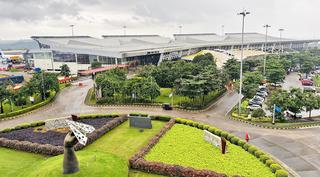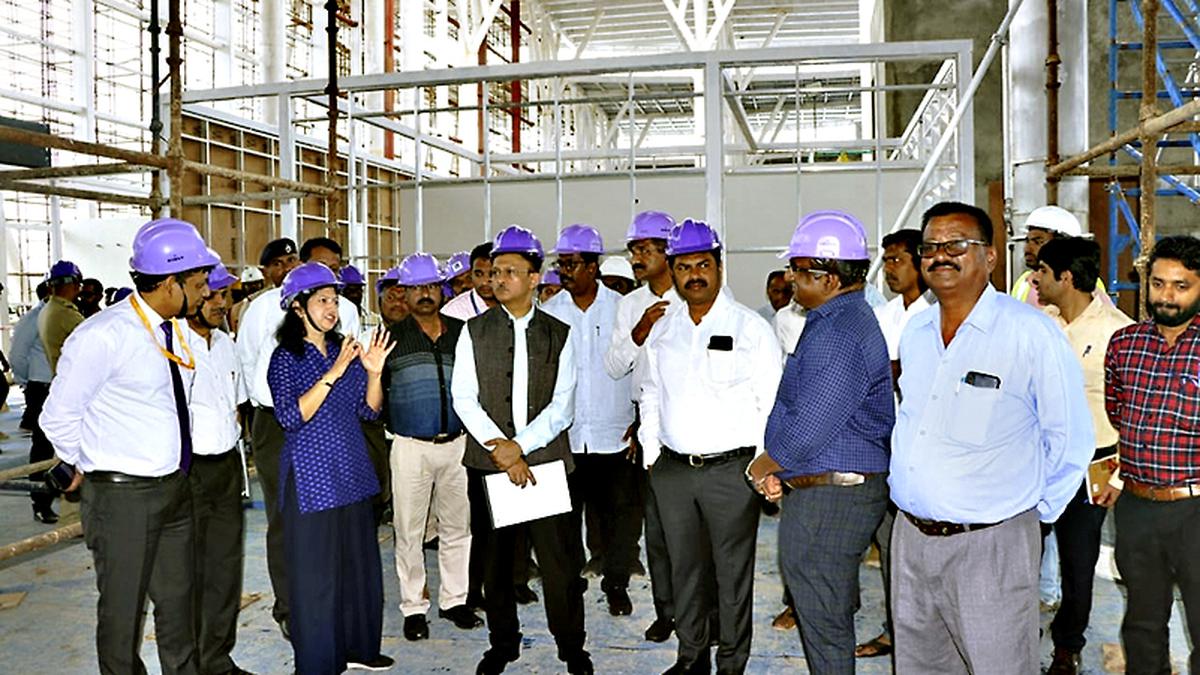Residents of Sogane village in Shivamogga district have announced plans to stage a large-scale protest in front of the newly inaugurated Shivamogga Airport, demanding fair compensation and rehabilitation for lands acquired during the airport’s construction. The demonstration, scheduled for later this week, comes after months of unfulfilled assurances from district authorities and the Karnataka Industrial Areas Development Board (KIADB). Villagers allege that despite repeated petitions, many affected families have not received the full compensation promised to them under the Land Acquisition Act. The protest is expected to draw farmers, local leaders, and activists from across the district in solidarity.
According to the protest organizers, over 250 families in Sogane and neighboring areas lost agricultural and residential land to the airport project, but only a fraction have been compensated adequately. “We gave up our fertile lands for the airport in good faith, believing it would bring development and jobs. But what we got instead was neglect and broken promises,” said S. Manjunath, one of the leaders of the agitation. The villagers claim that compensation amounts were inconsistently calculated, with some beneficiaries receiving payments while others were left waiting indefinitely. They have demanded a transparent re-evaluation of compensation and immediate settlement of pending dues.
The Shivamogga Airport, inaugurated earlier this year, has been projected as a key infrastructural milestone aimed at improving regional connectivity and boosting tourism in Malnad. However, residents of Sogane argue that the project has benefited outsiders more than locals. They allege that several job opportunities created by the airport have gone to non-residents, despite assurances of priority employment for displaced families. The villagers also expressed concern that access roads to their farmlands have been blocked, affecting daily mobility and agricultural activity. Protesters have warned that if the administration fails to act, they will intensify the agitation.
Longstanding Grievances and Administrative Apathy: Sogane
Villagers claim that their appeals to both the district administration and the Revenue Department have gone unanswered for over a year.
Many allege that officials have conducted no serious review of compensation disparities despite multiple reminders and legal notices.
Police on Alert as Protest Gains Momentum
Shivamogga police have stepped up security around the airport premises, anticipating a large turnout for the planned demonstration.
Authorities are in talks with village representatives to ensure the protest remains peaceful and does not disrupt flight operations.
The Sogane protest highlights a broader issue of rural displacement in Karnataka, where rapid infrastructure development often collides with farmers’ rights. In this case, the airport project, while strategically important for regional connectivity, has left many villagers feeling marginalized and unheard. Experts note that land acquisition conflicts are increasingly common in states undergoing fast-paced development, as mechanisms to ensure fair compensation and rehabilitation are either inadequately enforced or poorly monitored. For Sogane residents, the stakes are personal: land is not merely property but a source of livelihood, cultural identity, and social stability. The protest, therefore, is both an economic and social assertion of rights.

Local leaders have criticized the KIADB for what they describe as bureaucratic lethargy. They argue that the board, responsible for managing land acquisition and compensation, has failed to maintain consistent communication with affected families. Villagers recount instances where officials promised site visits or hearings that never materialized. The lack of clarity regarding compensation timelines and amounts has fueled frustration, prompting calls for the intervention of higher authorities, including the district collector and the state revenue minister. Activists insist that administrative apathy has only exacerbated tensions and increased the likelihood of confrontational protests.
Economic analysts observe that infrastructure projects like Shivamogga Airport are intended to stimulate local economies by attracting investment and tourism. However, in Sogane’s case, the benefits have been unevenly distributed. Many villagers complain that opportunities for employment and ancillary businesses have gone largely to outsiders or urban contractors. This perceived inequity has heightened resentment, with villagers insisting that development should include targeted measures to uplift the communities directly affected by land acquisition. Experts suggest that failure to integrate local residents into planning and employment structures often undermines the social legitimacy of such projects.
The protest also sheds light on the environmental dimension of airport development. Sogane is located in a semi-rural, agrarian belt, and villagers claim that construction has disrupted drainage channels and reduced groundwater availability. Some farmers report crop losses due to restricted water flow and soil compaction caused by heavy machinery during the airport construction phase. Environmental engineers warn that cumulative ecological disruption, combined with inadequate compensation, can lead to long-term socioeconomic stress, leaving communities vulnerable despite ostensibly modern infrastructure nearby.
Village elders have framed the protest as a moral obligation to future generations. They argue that surrendering land without fair recompense sets a dangerous precedent for other districts where infrastructure expansion is planned. Some elders have called for a formal audit of the airport’s land acquisition process, demanding that independent experts verify compensation calculations and the authenticity of documentation. These measures, they contend, would restore trust between villagers and the administration and prevent similar conflicts in upcoming projects.
The planned protest has gained attention beyond Shivamogga, drawing support from regional media outlets and social organizations advocating for farmers’ rights. Reports indicate that youth groups and student volunteers are mobilizing logistics, including transport and communication networks, to ensure maximum participation. Social media campaigns accompanying the protest have highlighted the grievances of Sogane residents, generating public sympathy and amplifying pressure on authorities to respond swiftly. Analysts note that such digital mobilization is increasingly critical in shaping government responses to rural agitations.
Officials from the Revenue and Revenue Recovery Departments have acknowledged receipt of petitions from Sogane residents. While they insist that compensation will be finalized “in accordance with legal procedures,” the villagers argue that the process has been unnecessarily slow and opaque. Some residents claim that the delay is causing financial hardship, particularly for families whose agricultural incomes were disrupted by the airport project. Community representatives are therefore demanding a fast-track resolution mechanism that ensures immediate payments and legally binding assurances of future support.

Legal experts point out that under the Right to Fair Compensation and Transparency in Land Acquisition, Rehabilitation and Resettlement Act, 2013, affected families are entitled not only to market-value compensation but also to rehabilitation support. In Sogane, however, villagers contend that the rehabilitation provisions have largely been ignored, leaving families without alternative housing, employment, or access to social welfare programs. Lawyers advocating for the villagers suggest filing public interest litigations if the administration fails to provide timely relief, potentially escalating the issue to the High Court of Karnataka.
The protest planning committee has outlined a series of staged actions to coincide with the demonstration. Initially, participants intend to conduct a peaceful sit-in near the airport gate, followed by symbolic marches highlighting affected lands. Organizers emphasize that the protest will remain nonviolent and focused on dialogue with authorities, despite heightened frustration among villagers. They have requested police and district officials to maintain an environment conducive to constructive negotiation rather than confrontation, indicating a preference for legal and administrative channels over aggressive agitation.
Civil society groups supporting Sogane residents stress that the airport project could have been implemented more inclusively. They argue that participatory planning — involving local communities in decision-making — would have prevented grievances from escalating into mass protests. Experts recommend structured stakeholder engagement, transparent communication of project benefits, and immediate grievance redressal as essential tools to align infrastructure development with social equity. Such measures, they say, are critical in ensuring that economic growth does not come at the cost of community disenfranchisement.
The protest has also reignited political debates at the district and state levels. Opposition leaders have criticized the ruling government for failing to prioritize the welfare of farmers over infrastructure ambitions. They argue that public sentiment in Sogane reflects broader dissatisfaction with land acquisition policies and the perceived marginalization of rural communities. Supporters of the administration counter that delays in compensation are often procedural rather than deliberate, emphasizing the complexity of verifying titles and land records. Nevertheless, the political pressure surrounding the protest is expected to influence forthcoming administrative decisions.
Experts in rural development warn that unresolved land disputes could undermine long-term trust in government-led projects. They highlight that future infrastructure initiatives in Shivamogga and nearby districts may encounter resistance if grievances like those in Sogane are not addressed promptly. The erosion of public confidence can lead to legal challenges, project delays, and increased costs, negating the intended economic benefits. Development planners are therefore urged to consider social legitimacy as an integral factor alongside financial and technical feasibility when implementing large-scale projects.
Media coverage of the planned Sogane protest has amplified both the villagers’ demands and the administration’s responses. Television reports and digital news platforms have interviewed residents, highlighting personal stories of hardship, delayed compensation, and disrupted livelihoods. The media attention has intensified scrutiny on the KIADB and district authorities, who now face heightened pressure to deliver tangible results before the protest escalates. Analysts suggest that continuous reporting may influence administrative accountability, compelling faster resolution and increased transparency in decision-making.
In response to mounting pressure, the district administration has scheduled a review meeting with representatives of Sogane village, KIADB officials, and the Revenue Department. Authorities have indicated that they will reassess compensation calculations, expedite pending payments, and explore options for rehabilitation and livelihood support. Villagers, while cautiously optimistic, insist on written commitments and strict timelines. They have warned that failure to honor promises could result in extended demonstrations, including potential road blockades and broader mobilization of affected communities from neighboring villages.
Finally, the Sogane protest underscores a critical lesson for future development planning in Karnataka: infrastructure growth must be accompanied by proactive engagement with local communities. Experts emphasize that equitable land acquisition, timely compensation, and transparent grievance mechanisms are essential to prevent conflicts and ensure that development benefits are shared fairly. As Shivamogga Airport continues to operate, the resolution of Sogane residents’ grievances will serve as a test case for balancing economic progress with social justice, providing a blueprint for sustainable and inclusive development across the state.
The planned agitation underscores a growing rift between rural communities and government agencies over large-scale development projects. Sogane residents argue that while infrastructure projects are welcome, they must not come at the expense of farmers’ livelihoods and dignity. “We are not against progress,” said a protesting farmer. “But progress should not mean exploitation.” Local activists from farmers’ unions and social organizations have joined the villagers, framing the protest as a fight for justice and accountability. The district administration, meanwhile, has promised to hold a meeting with representatives from the affected villages to review grievances, though residents say they have heard similar assurances before without results.
Follow: Karnataka Government
Also read: Home | Channel 6 Network – Latest News, Breaking Updates: Politics, Business, Tech & More

